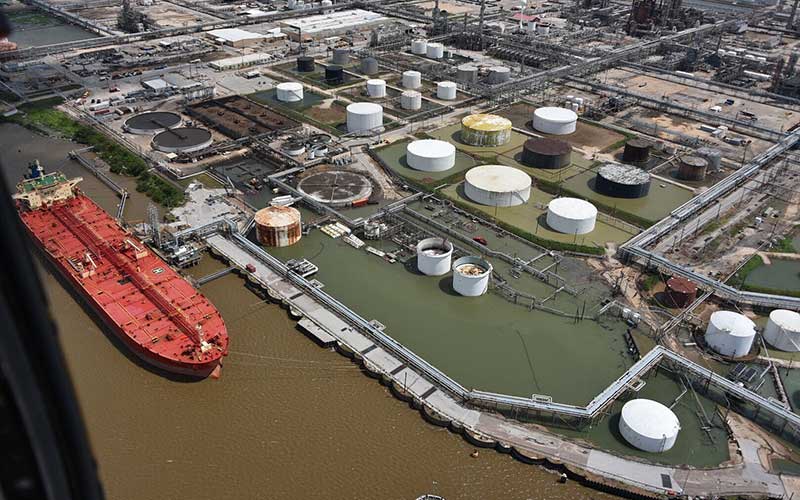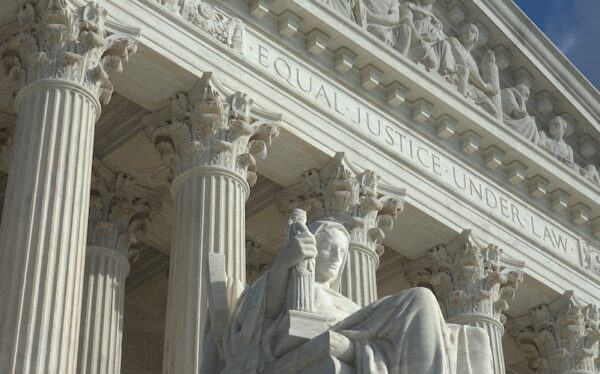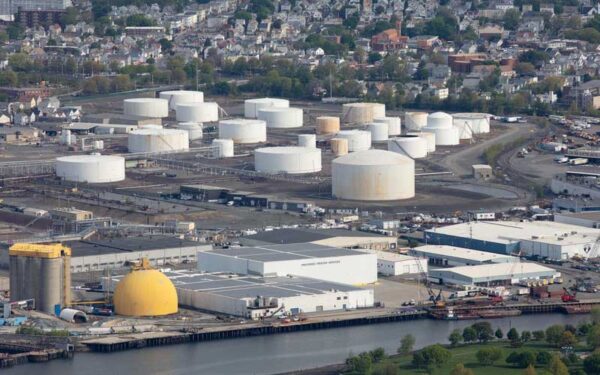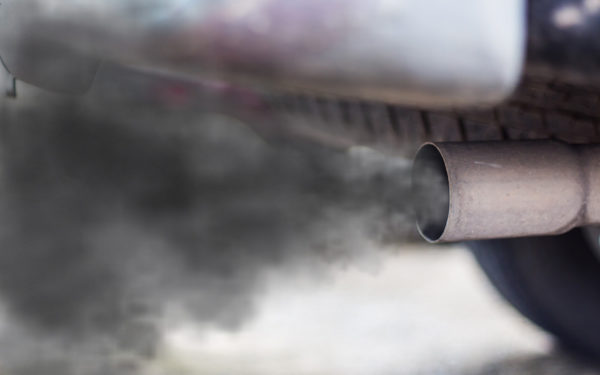
Coast Guard aircrews conduct flyovers to assess the ports of Houston, Texas City, Freeport and Galveston. Photo: U.S. Coast Guard by Petty Officer 1st Class Patrick Kelley
Over six days, Hurricane Harvey dumped 27 trillion gallons of water on Houston and parts of the Gulf Coast, leaving a wide swath of destruction and toxic pollution for communities to deal with as they try to rebuild from the storm. 100,000 homes incurred damage or were lost altogether, and restoration efforts are estimated to cost $190 billion.
Even as the flood waters destroyed homes and businesses, they also inundated energy facilities owned by companies like ExxonMobil, Shell, and Chevron Phillips, whose inexcusable lack of preparedness for such floods has placed the health and safety of millions of Texas residents at risk.
Disturbing images of oil slicks and reports of cancer-causing chemicals released into the air and water should serve as an overdue wake-up call for these Big Oil giants, but not just for their Texas facilities. ExxonMobil and Shell both operate large oil storage facilities here in New England (one of Exxon’s sits on the Mystic River in Everett, Massachusetts, and one of Shell’s overlooks the Providence River in Rhode Island). Just like their Gulf counterparts, these facilities are poised to spew toxic chemicals into our waters and nearby neighborhoods if flooded by even a category 1 storm (Hurricane Harvey was a category 4 storm when it made landfall).
Exxon Knows the Risks, But Leaves Its Facilities Unprepared
In the wake of Hurricane Harvey, the Center for Biological Diversity reports that refineries and petrochemical plants have released 1 million pounds of hazardous pollutants into the air, including benzene, hexane, hydrogen sulfide, sulfur dioxide, toluene, and xylene. They estimate that, overall, air pollutants released from all oil and gas facilities in the region total an astounding 5.46 million pounds. In one Houston neighborhood near a Valero Energy refinery, officials have reported high levels of benzene, a known carcinogen. Concerns for residents there include short-term risks of dizziness, nausea, and lightheadedness, and, over the long term, increased risk of cancer.
In a 2015 blog, ExxonMobil forecast what a storm like Harvey would mean for the region, writing, “… it only takes one storm to do major damage. A tropical storm or hurricane can destroy people’s lives and property. And its impact can incapacitate much of the energy production-and-supply infrastructure assembled along the Gulf of Mexico.”
Yet despite its own dire prediction two years in advance of Hurricane Harvey, ExxonMobil’s facilities were not prepared for the impacts of such a storm. From August 27 to September 2, ExxonMobil filed nine reports with the National Response Center regarding its facilities in Baytown, Beaumont, and Houston, most of which reported oil discharges and releases of toxic chemicals such as benzene, toluene, and xylene.
Lessons from Houston Must be Heeded Here at Home
The language ExxonMobil used to describe the risks facing its Gulf of Mexico facilities echoes how the company has described those facing communities surrounding its Everett oil terminal. In a recent letter to EPA attempting to justify why records related to the Everett terminal are too sensitive to be released publicly, ExxonMobil wrote, “Given the Terminal’s location, a security incident leading to a release at the Terminal would likely have catastrophic effects on both human life and the environment.”
Hurricane Harvey made landfall as a Category 4 hurricane. Most of Exxon’s Everett facility would be flooded by storm surge from even a Category 1 storm. Many of the same chemicals that were released during Harvey are present at the Everett Terminal, including benzene, toluene, and xylene. However, despite acknowledging the “catastrophic” effects its Everett terminal would have on surrounding neighborhoods and the environment, ExxonMobil has failed to protect it against rising seas, increasingly intense rainfall, and storm surge.
Shell’s Providence Terminal no more prepared than Exxon’s Everett facility to withstand rising seas, increasingly intense rainfall, and storm surge – despite the fact that its location, elevation, and lack of preventative infrastructure make it especially vulnerable to these risks. Local communities in and around Providence are directly in harm’s way, and have no assurance that they will be protected from pollutants released and discharged from the site into the Providence River, Narragansett Bay, and their communities.
Legal Action to Hold Exxon and Shell Accountable
According to the National Climate Assessment, “The intensity, frequency, and duration of North Atlantic hurricanes, as well as the frequency of the strongest (Category 4 and 5) hurricanes, have all increased since the early 1980s.” It is not a matter of if the next storm comes, but when. The impacts of Hurricane Harvey were foreseeable, yet ExxonMobil and Shell left their facilities in Houston vulnerable – and now the surrounding communities are paying a terrible, long-term price. It is difficult to grapple with such a massive corporate failure. We can’t risk the same happening here in New England.
Last September, Conservation Law Foundation filed a first-in-the-nation lawsuit against ExxonMobil for failing to harden its Everett Terminal against these impacts and endangering surrounding communities and the environment. We have filed a similar suit against Shell over its Providence facility. The first hearing in the Exxon suit will be held tomorrow, when Exxon’s attorneys will argue that our case should be dismissed. But the destruction wrought by Harvey – and the oil giant’s failure to live up to its responsibility to safeguard its neighbors from harm – can’t be dismissed. We will continue fighting to protect vulnerable communities and our environment from such corporate indifference and to hold Big Oil accountable for its actions.



